The AI Data Centre Space Constraint and Nvidia’s Solution
The growth of artificial intelligence has pushed data centers to their physical limits. About Nvidia Spectrum-XGS. As workloads expand, single-site facilities are struggling with power, cooling, and space constraints. Building ever larger mega-centers is becoming less viable—both economically and environmentally.
According to Artificial Intelligence News, Nvidia’s answer is Spectrum-XGS Ethernet, a networking innovation that allows multiple distributed data centers to operate as one. This introduces a new “scale-across” dimension, complementing the traditional “scale-up” (bigger processors) and “scale-out” (more servers per site) approaches.
Spectrum-XGS optimizes data transfers across long distances with features like:
- Distance-adaptive algorithms that reduce latency.
- Advanced congestion management for consistent throughput.
- Real-time telemetry to dynamically optimize traffic.
With these improvements, Nvidia nearly doubles the performance of its NCCL collective communication library when used across distributed clusters (Nvidia Newsroom).
What Is Spectrum-XGS and How It Works
Instead of forcing hyperscalers to centralize everything in one place, Spectrum-XGS creates giga-scale AI super-factories by linking multiple smaller facilities. Infrastructure provider CoreWeave is already deploying this technology, effectively transforming distributed centers into one unified compute fabric (Artificial Intelligence News).
For industries like climate research, this means lower costs and faster processing of vast datasets. Readers can explore our coverage of AI for Climate: Extreme-Weather Forecasts to see how compute-heavy workloads directly benefit from this kind of innovation.
Industry Impact: CoreWeave’s AI Super-Factories
By reducing reliance on mega-sites, Spectrum-XGS:
- Lowers regulatory and environmental resistance.
- Provides greater resiliency, since workloads can be shifted across regions.
- Reduces capital expenditure, since smaller facilities can be incrementally added.
This aligns with other networking trends like Broadcom’s Jericho4 chip that we discussed in Building the Future of AI: Jericho4 and the AI Networking Surge. Together, these advances show networking is no longer a bottleneck—it’s becoming a key enabler of AI growth.
Meta Shifts Into AI Partnerships and Wearables
From Social Media to AI Infrastructure
At the same time that Nvidia is transforming hardware, Meta Platforms is pivoting its business model. Once known purely as a social media giant, Meta is reassessing its valuation by embracing AI partnerships and wearables.
A recent analysis from Simply Wall St highlights that Meta’s investments and partnerships go far beyond Facebook and Instagram. This shift reflects a broader industry trend: AI is no longer a feature—it’s the business.
Strategic Moves: Google Cloud Deal and Scale AI Investment
Meta recently struck a $10 billion, six-year deal with Google Cloud to host and train its next-generation AI models (The Times). This agreement ensures Meta can leverage distributed infrastructure without building everything in-house.
In addition, Meta invested $15 billion in Scale AI, doubling the startup’s valuation (Financial Times). This not only secures access to critical training data pipelines but also locks in partnerships with some of the world’s top AI engineers.
For context, this strategy is not unlike Anthropic’s rapid expansion of its Opus and Sonnet models—see our report on Anthropic in August for more. Tech giants are betting billions to ensure their long-term AI competitiveness.
Where Infrastructure Meets Corporate Strategy – Nvidia Spectrum-XGS
The synergy between Nvidia’s Spectrum-XGS and Meta’s corporate strategy is clear. Nvidia provides the connective tissue for distributed super-factories, while Meta shifts to an AI-first future that depends on such high-performance infrastructure.
- For Nvidia: corporate giants like Meta represent a ready market for Spectrum-XGS.
- For Meta: access to distributed, low-latency compute is a competitive necessity.
This intersection illustrates the co-evolution of hardware innovation and corporate strategy. Companies like Meta can no longer rely only on advertising revenue; their future depends on leveraging the most advanced AI infrastructure available.
Our earlier analysis of the AI Infrastructure Race: From Broadcom’s Jericho Chip to PCIe Gen 6 shows that compute hardware is becoming a geopolitical and corporate differentiator, not just a technical one.
Internal Blog Connections and Further Reading
For readers who want to explore related developments across AI, here are some key articles from our own archive:
- Genie 3: DeepMind’s World Model Turns Prompts into Playable Worlds
- AI for Climate: Extreme-Weather Forecasts and What They Change
- Broadcom Jericho4 and the AI Networking Surge
- AI Infrastructure Race: Jericho to PCIe Gen 6
- Anthropic in August: Opus 4.1 and Government Rollout
These links help contextualize Nvidia’s and Meta’s moves within the broader AI ecosystem.
Conclusion Nvidia Spectrum-XGS
AI’s future depends not just on smarter algorithms but also on smarter infrastructure and corporate strategy. Nvidia’s Spectrum-XGS is solving the problem of distributed compute at giga-scale, while Meta’s partnerships and investments signal a long-term pivot into AI.
Together, these developments underscore a fundamental truth: the pace of AI innovation is increasingly determined by the marriage of hardware breakthroughs and strategic investment.




